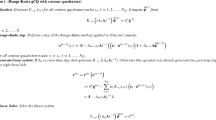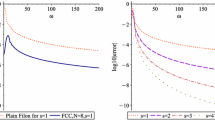Abstract
This paper is devoted to explore the convolution quadrature based on a class of two-point Hermite collocation methods. Incorporating derivatives into the numerical scheme enhances the accuracy while preserving stability, which is confirmed by the convergence analysis for the discretization of the initial value problem. Moreover, we employ the resulting quadrature to evaluate a class of highly oscillatory integrals. The frequency-explicit convergence analysis demonstrates that the proposed convolution quadrature surpasses existing convolution quadratures, achieving the highest convergence rate with respect to the oscillation among them. Numerical experiments involving convolution integrals with smooth, weakly singular, and highly oscillatory Bessel kernels illustrate the reliability and efficiency of the proposed convolution quadrature.





Similar content being viewed by others
References
Banjai, L., López-Fernández, M.: Efficient high order algorithms for fractional integrals and fractional differential equations. Numer. Math. 141(2), 289–317 (2019)
Banjai, L., Lubich, C., Nick, J.: Time-dependent acoustic scattering from generalized impedance boundary conditions via boundary elements and convolution quadrature. IMA J. Numer. Anal. 42(1), 1–26 (2022)
Banjai, L., Sayas, F.: Integral Equation Methods for Evolutionary PDE: A Convolution Quadrature Approach. Springer Nature (2022)
Brunner, H., Davies, P.J., Duncan, D.B.: Discontinuous Galerkin approximations for Volterra integral equations of the first kind. IMA J. Numer. Anal. 29(4), 856–881 (2009)
Davies, P.J., Duncan, D.B.: Stability and convergence of collocation schemes for retarded potential integral equations. SIAM J. Numer. Anal. 42(3), 1167–1188 (2004)
Davies, P.J., Duncan, D.B.: Convolution spline approximations for time domain boundary integral equations. J. Integral Equ. Appl. 26(3), 369–410 (2014)
Iserles, A., Nørsett, S.P.: Efficient quadrature of highly oscillatory integrals using derivatives. Proc. R. Soc. A Math. Physi. Eng. Sci. 461(2005), 1383–1399 (2005)
Jin, B., Li, B., Zhou, Z.: Correction of high-order BDF convolution quadrature for fractional evolution equations. SIAM J. Sci. Comput. 39(6), A3129–A3152 (2017)
Lang, S.: Complex Analysis. Springer, Berlin (2003)
Levin, D.: Procedures for computing one- and two-dimensional integrals of functions with rapid irregular oscillations. Math. Comput. 38(158), 531–538 (1982)
Li, B., Xiang, S., Liu, G.: Laplace transforms for evaluation of Volterra integral equation of the first kind with highly oscillatory kernel. Comput. Appl. Math. 38, 1–18 (2019)
Li, B., Ma, S.: Exponential convolution quadrature for nonlinear subdiffusion equations with nonsmooth initial data. SIAM J. Numer. Anal. 60(2), 503–528 (2022)
López-Fernández, M., Sauter, S.: Generalized convolution quadrature based on Runge–Kutta methods. Numer. Math. 133(4), 743–779 (2016)
Lubich, C.: Convolution quadrature and discretized operational calculus. I. Numerische Mathematik 52(2), 129–145 (1988)
Lubich, C.: Convolution quadrature and discretized operational calculus. II. Numerische Mathematik 52(4), 413–425 (1988)
Lubich, C.: On convolution quadrature and Hille-Phillips operational calculus. Appl. Numer. Math. 9(3–5), 187–199 (1992)
Lubich, C., Ostermann, A.: Runge–Kutta methods for parabolic equations and convolution quadrature. Math. Comput. 60(201), 105–131 (1993)
Ma, J., Liu, H.: On the convolution quadrature rule for integral transforms with oscillatory Bessel kernels. Symmetry 10(7), 239 (2018)
Olver, F., Lozier, D., Boisvert, R., Clark, C.: NIST Handbook of Mathematical Functions. Cambridge University Press, Cambridge (2010)
Olver, S.: Moment-free numerical integration of highly oscillatory functions. IMA J. Numer. Anal. 26(2), 213–227 (2006)
Sayas, F.: Retarded Potentials and Time Domain Boundary Integral Equation: A Road Map. Springer, Berlin (2016)
Schädle, A., López-Fernández, M., Lubich, C.: Fast and oblivious convolution quadrature. SIAM J. Sci. Comput. 28(2), 421–438 (2006)
Trefethen, L.N.: Approximation Theorey and Approximation Practice. SIAM, Philadelphia (2013)
Wang, Y., Xiang, S.: Fast and stable augmented Levin methods for highly oscillatory and singular integrals. Math. Comput. 91, 1893–1923 (2022)
Xiang, S., Wang, H.: Fast integration of highly oscillatory integrals with exotic oscillators. Math. Comput. 79(270), 829–844 (2009)
Xiang, S., Brunner, H.: Efficient methods for Volterra integral equations with highly oscillatory Bessel kernels. BIT Numer. Math. 53(1), 241–263 (2013)
Xu, K., Loureiro, F.: Spectral approximation of convoution operators. SIAM J. Sci. Comput. 40(4), A2336–A2355 (2018)
Acknowledgements
We express our sincere gratitude to anonymous reviewers for their insightful comments, which significantly enhanced the quality of our paper. J. Ma’s work was partly supported by National Natural Science Foundation of China (No. 11901133) and Science and Technology Foundation of Guizhou Province (No. QKHJC[2020]1Y014).
Author information
Authors and Affiliations
Corresponding author
Ethics declarations
Conflict of interest
The authors have no relevant financial or non-financial interests to disclose.
Additional information
Communicated by Stefano De Marchi.
Publisher's Note
Springer Nature remains neutral with regard to jurisdictional claims in published maps and institutional affiliations.
Rights and permissions
Springer Nature or its licensor (e.g. a society or other partner) holds exclusive rights to this article under a publishing agreement with the author(s) or other rightsholder(s); author self-archiving of the accepted manuscript version of this article is solely governed by the terms of such publishing agreement and applicable law.
About this article
Cite this article
Ren, H., Ma, J. & Liu, H. A convolution quadrature using derivatives and its application. Bit Numer Math 64, 8 (2024). https://doi.org/10.1007/s10543-024-01009-w
Received:
Accepted:
Published:
DOI: https://doi.org/10.1007/s10543-024-01009-w




